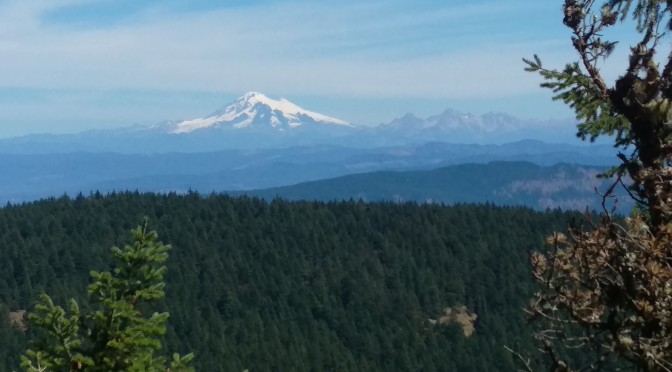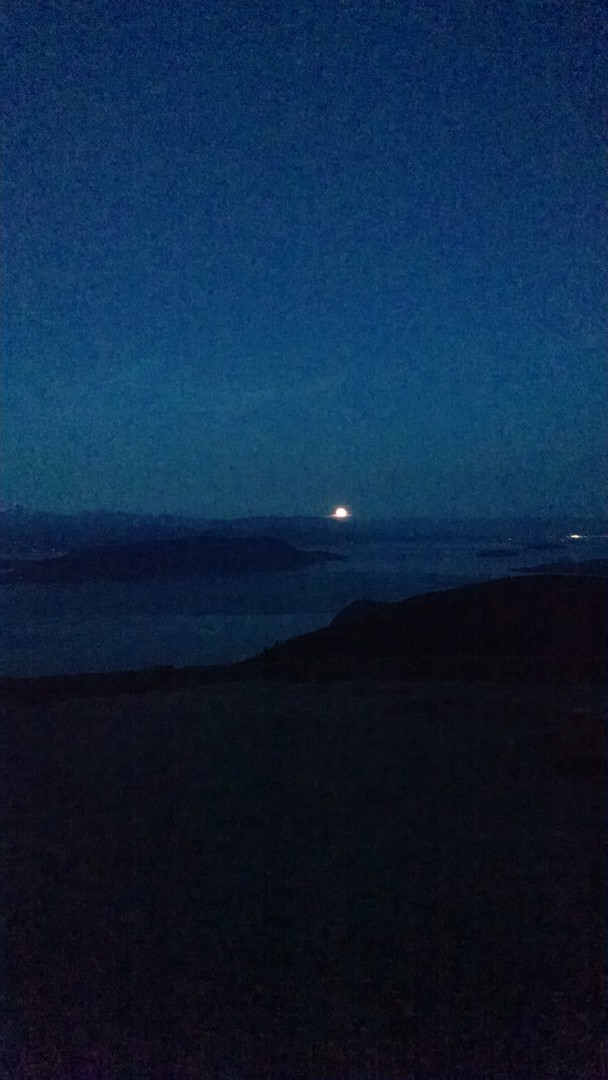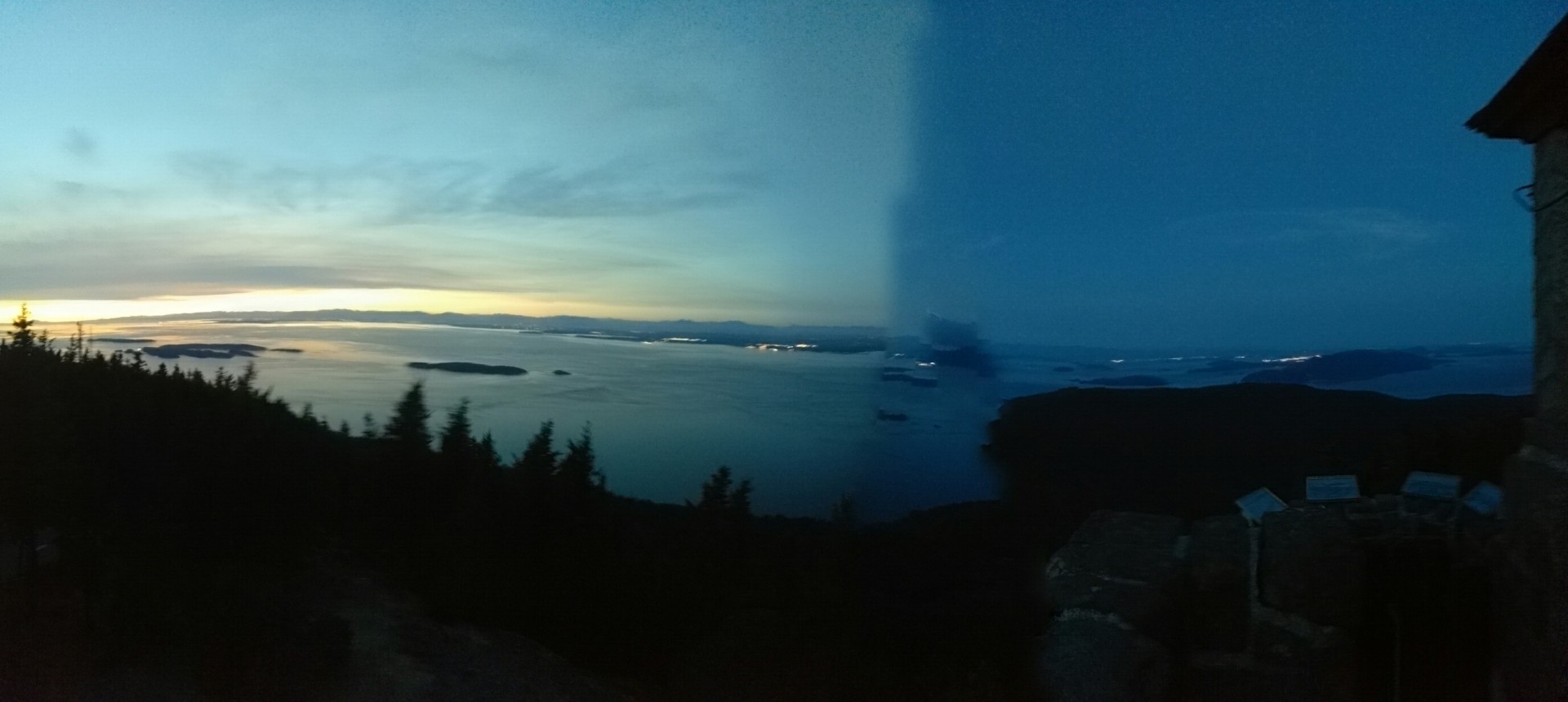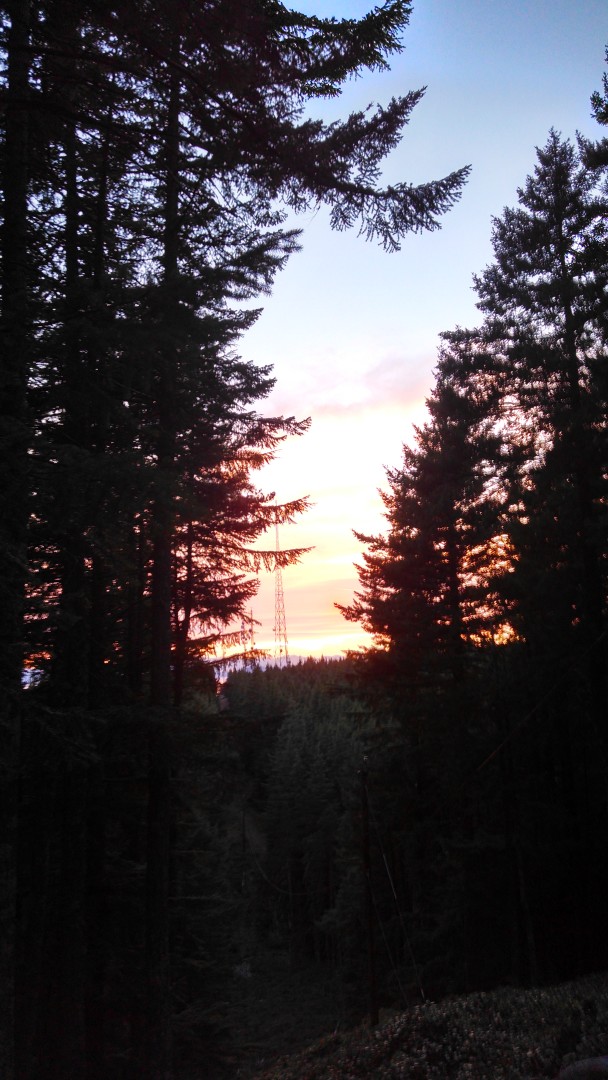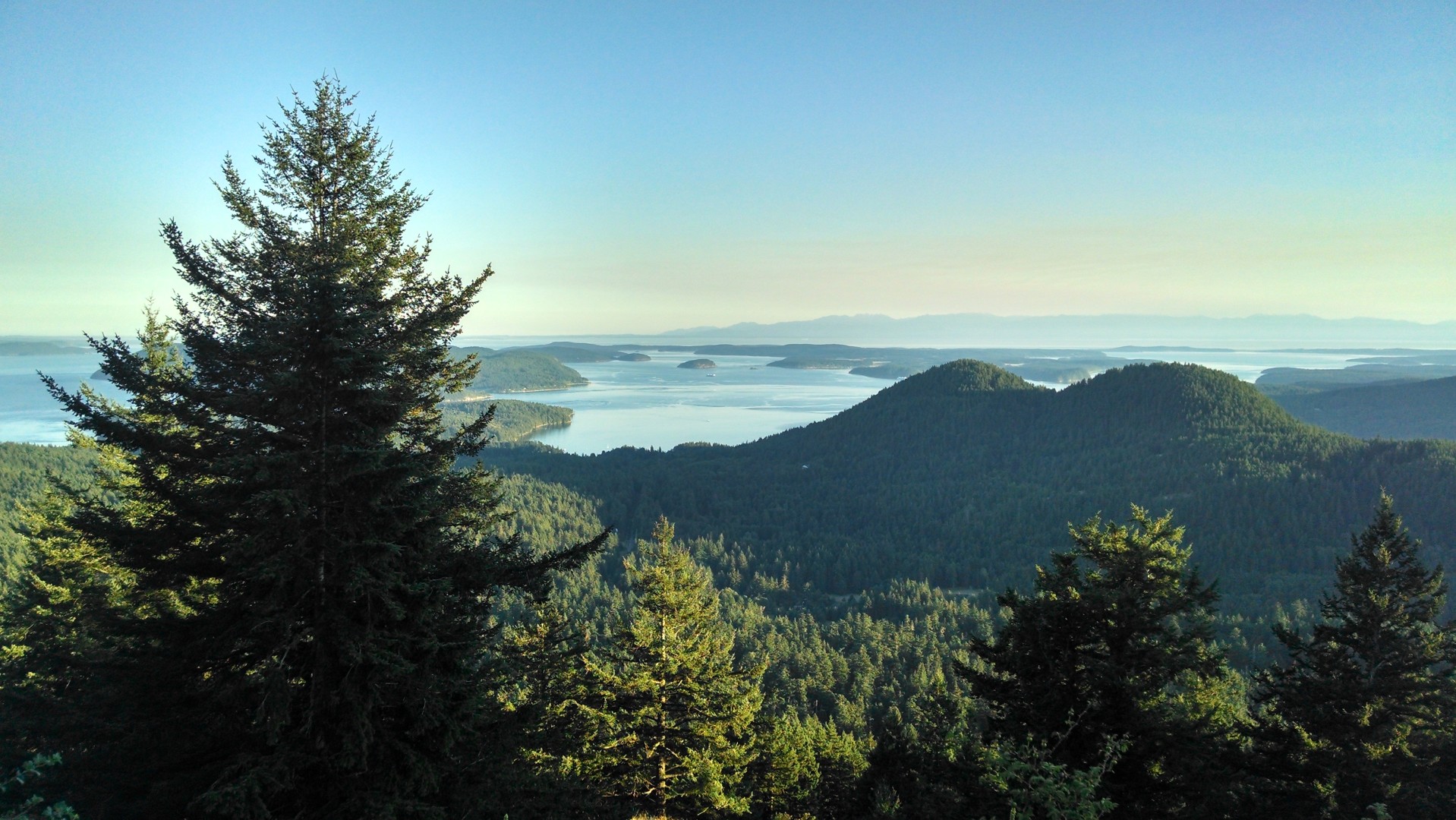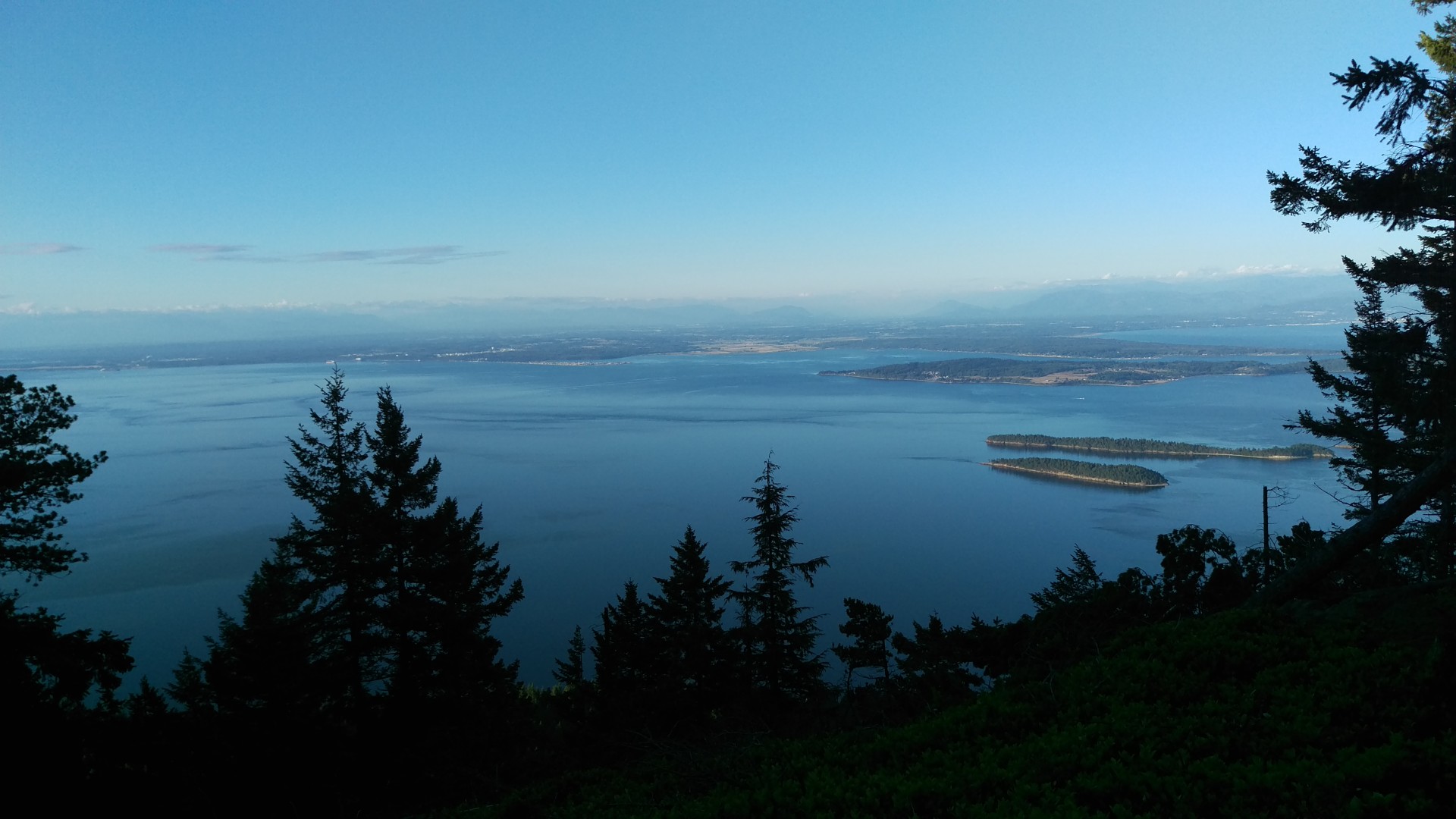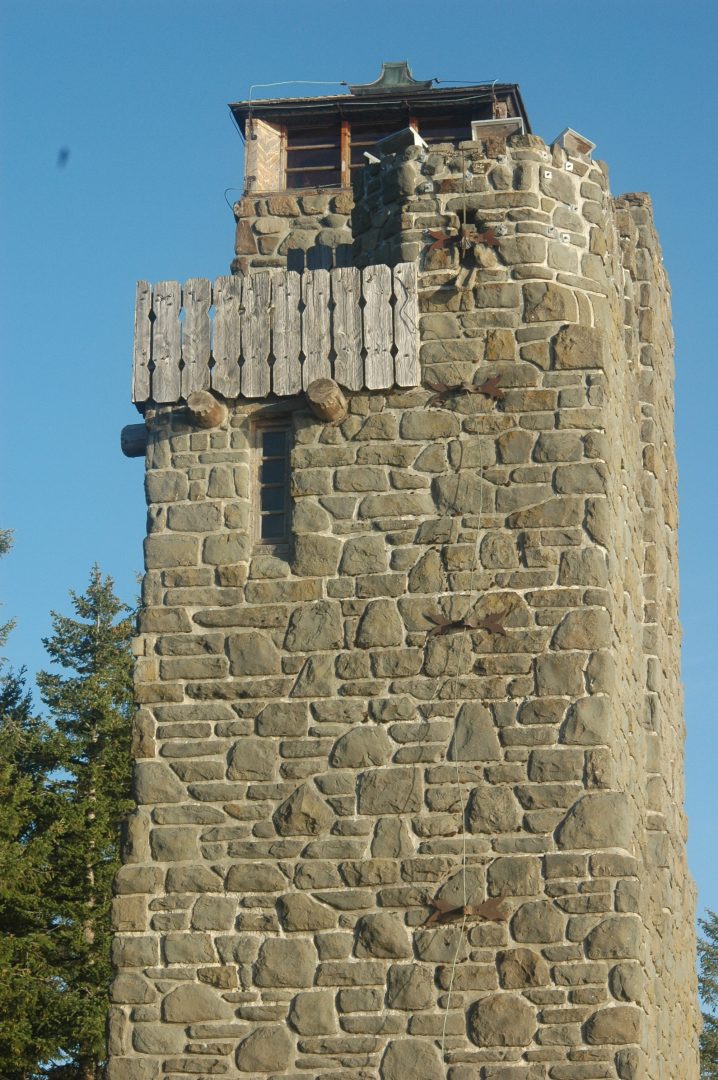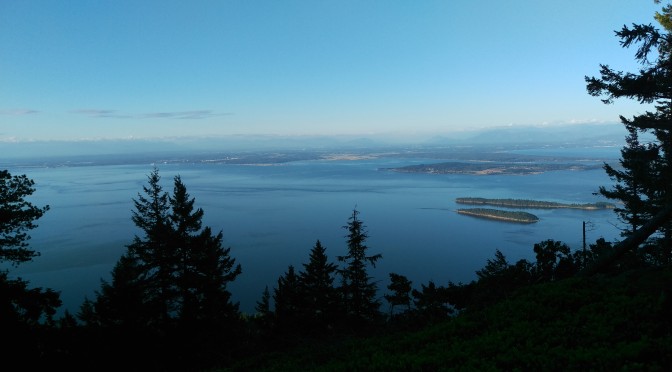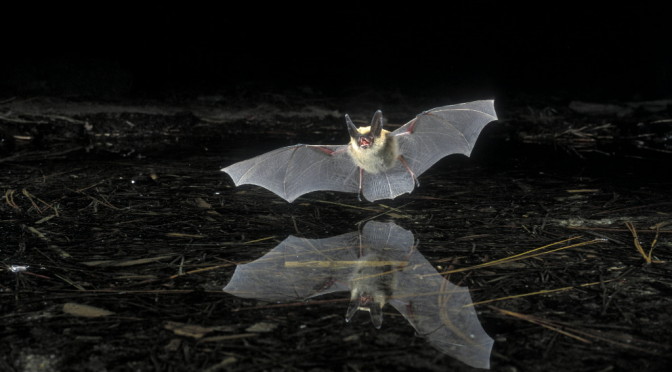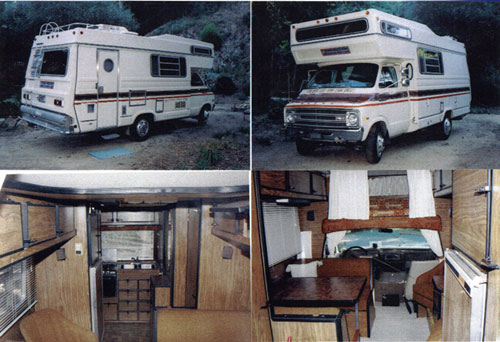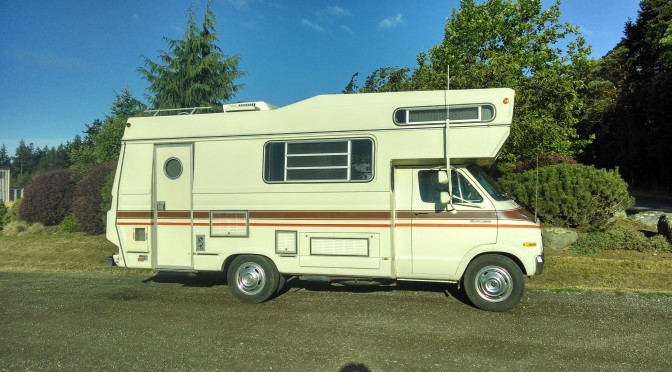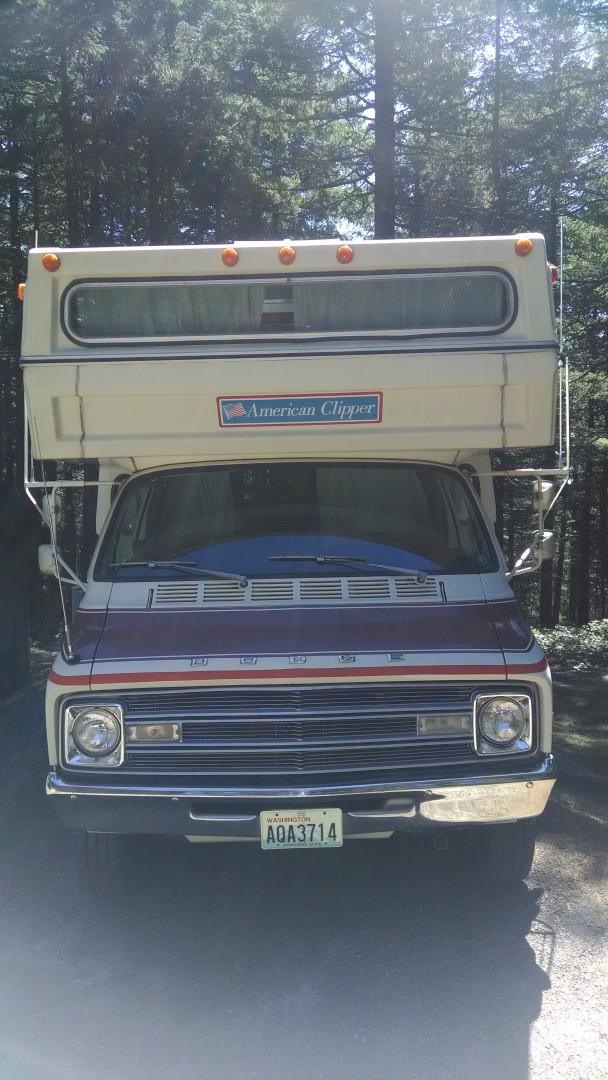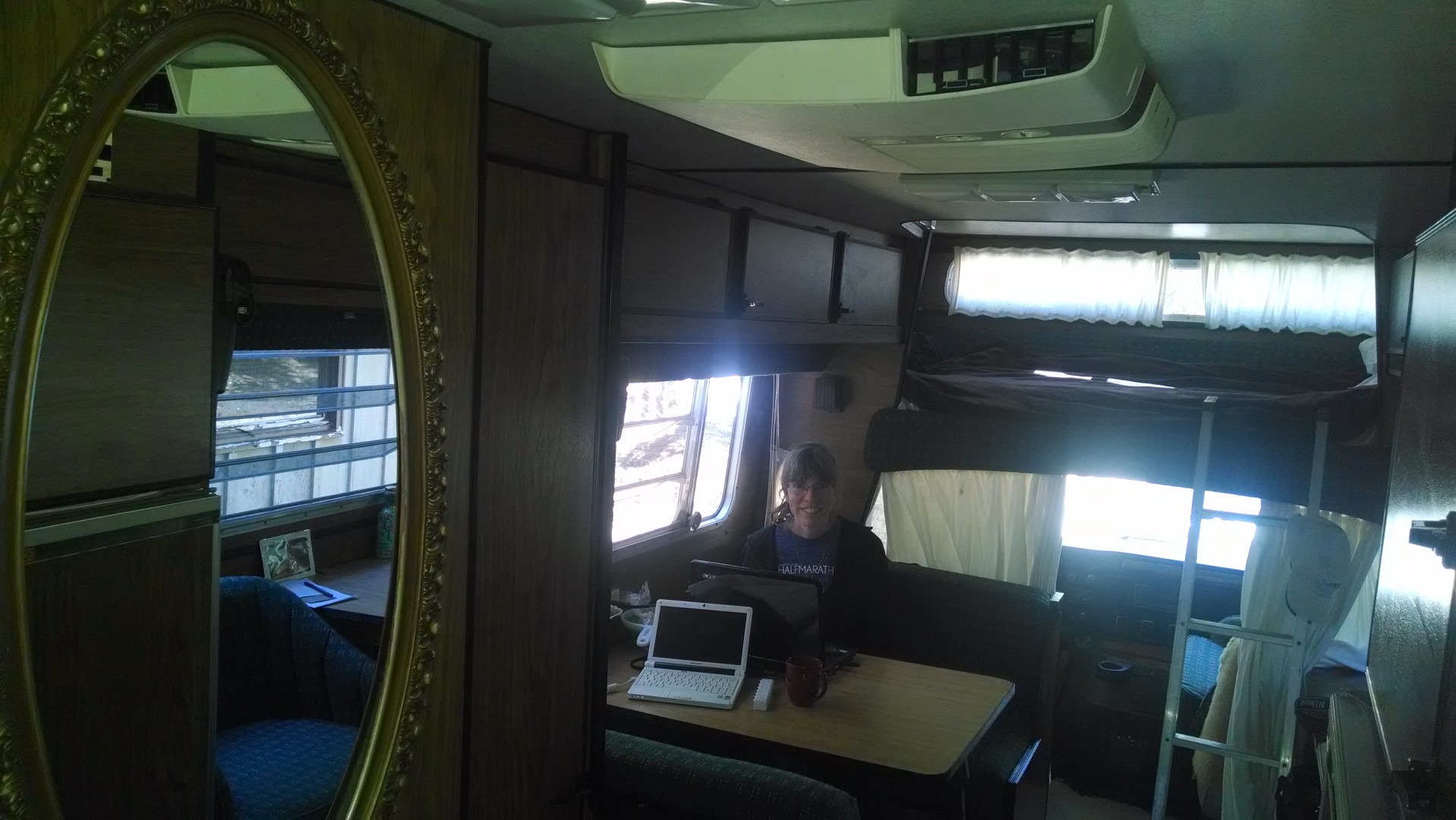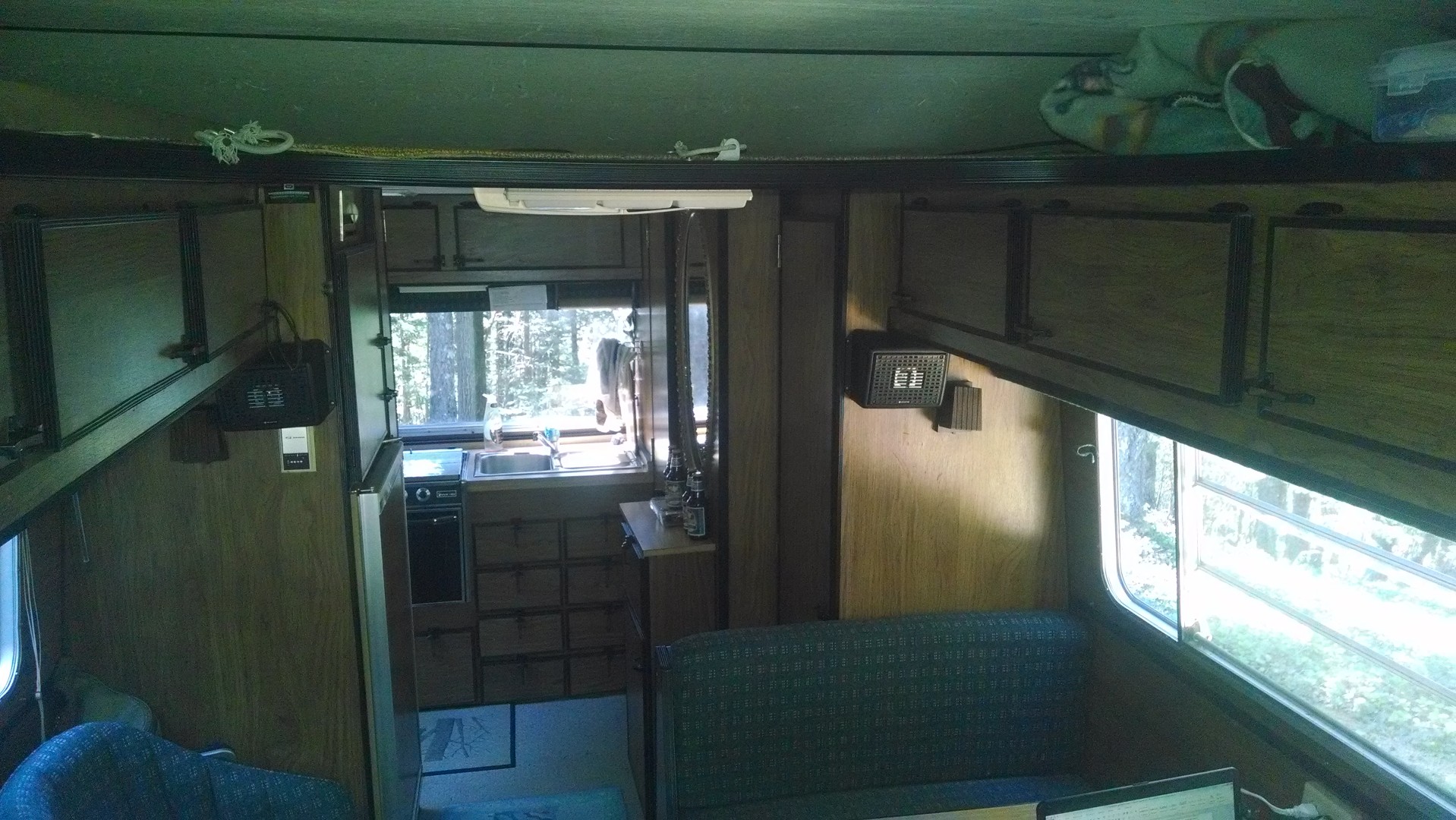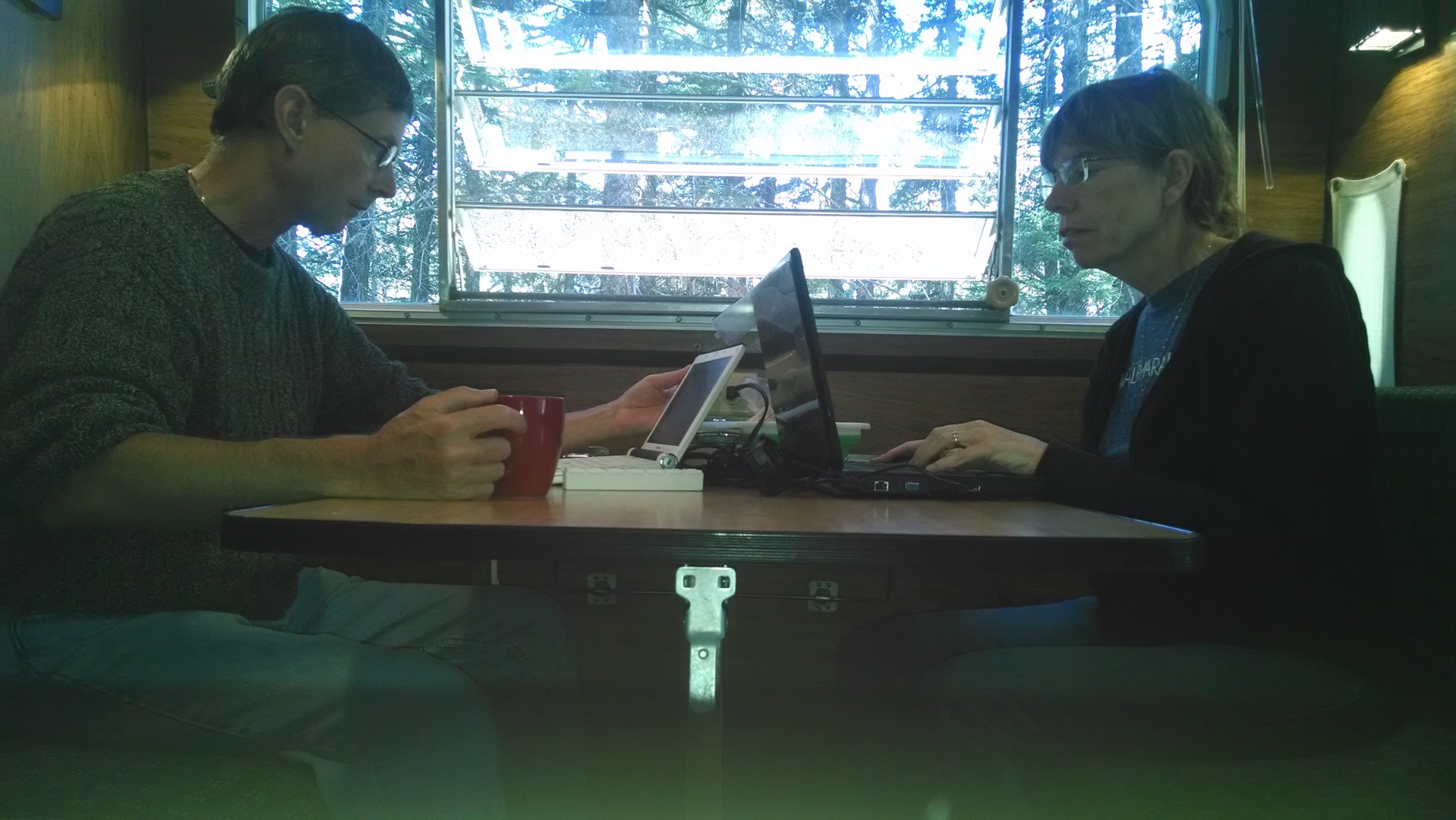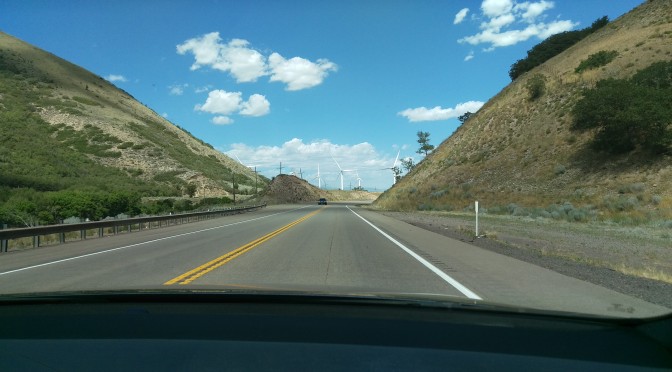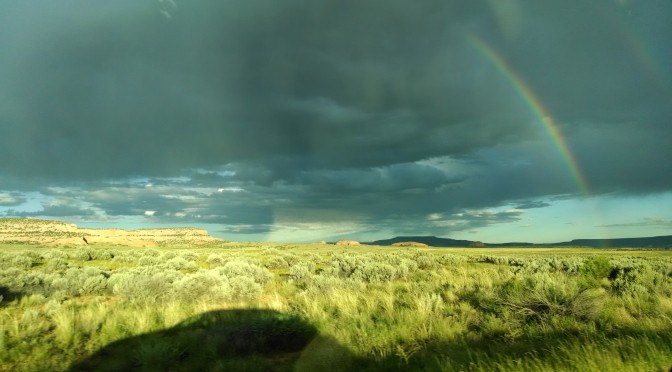Category Archives: Road Trip: 2015
Summit to Twin Lakes Hike
Hiking the Summit to Twin Lakes
One of the major benefits of living at Moran State Park is the abundance of hiking trails–almost 40 miles of trails in the 5252-acre state park. Some of the trails are only open to hikers, while others allow horses and still others permit mountain bikes in the wintertime. Because we’re based at the tower on top of Mount Constitution, the highest point in the San Juan Islands, all trails lead downhill.
And it’s a heck of a downhill. The shortest trail–that to Twin Lakes–is probably also the steepest. It descends 1289 feet to a pair of lakes 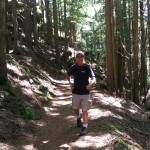 a mile and a half away. The brochure describes it as “easy to difficult,” with the easy part being around the lakes themselves. It’s a challenging hike on the way back up.
a mile and a half away. The brochure describes it as “easy to difficult,” with the easy part being around the lakes themselves. It’s a challenging hike on the way back up.
The trails are well maintained, though deadfalls over the summer mean one has to step over a few of them. Come September, the local mountain biking group will return to clear the paths for winter biking, and then rangers will clear them again in the spring.
Most of the trees–lodgepole pine, Western red cedar, Western hemlock, and Douglas fir–are what I would call “old growth,” though compared to some of California’s sequoias they are probably just mere saplings. Many of them stand more than 100 feet tall, but there is little of the underbrush found in Eastern forests.
Elliott and I saw and heard a raven (though for a brief time I was convinced it was a bald eagle). An interesting fact from the Summit Learning Center: a circling group of flying vultures is called a kettle, because it resembles the bubbles in a kettle of boiling water. Otherwise, our only wildlife viewing was a curious chipmunk.
The trail down to Twin Lakes is variable. Some of the path is filled with loose rock and fairly narrow, while other sections are wider and easy for trail running (at least for this novice). There are only a couple of times where Mt. Baker can be seen. Still, the feeling of being “one with the wilderness” is everpresent.
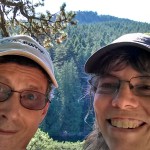 The hike around the lake is through rocky trails, and hikers venture onto a part of the local YMCA’s Camp Orlika, which shares a border with the lakes. Kids were swimming in the lake, which we were later told was full of leeches. We took our first selfie here.
The hike around the lake is through rocky trails, and hikers venture onto a part of the local YMCA’s Camp Orlika, which shares a border with the lakes. Kids were swimming in the lake, which we were later told was full of leeches. We took our first selfie here.
And then we started back up. I had to stop at nearly every switchback to catch my breath. As Elliott said, this is like going to the top of the Empire State Building on a handicapped ramp. We finished the hike in 2-1/4 hours (including going around the lake, stopping for photos, and so forth), and felt renewed, refreshed, and out of breath.
Bat Research on Orcas Island
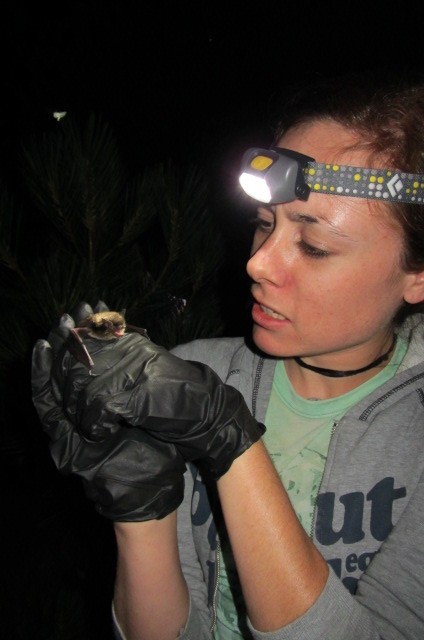 Last night I attended a sunset Bat Talk presented by young scientist and educator whose passion for her subject was utterly infectious. She is Rochelle Kelly, Ph.D. candidate at the Department of Biology, University of Washington. (I think of her this morning as the Bat Girl.)
Last night I attended a sunset Bat Talk presented by young scientist and educator whose passion for her subject was utterly infectious. She is Rochelle Kelly, Ph.D. candidate at the Department of Biology, University of Washington. (I think of her this morning as the Bat Girl.)
This woman knows her subject, and wasn’t shy about presenting the cool, post-graduate level facts and bleeding edge science being done in the world of bat research.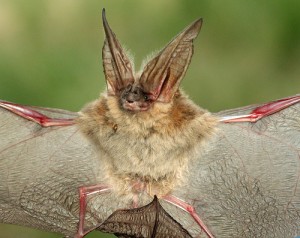
There are ten different species of bats on Orcas Island. They are nocturnal flying mammals, of course. One of the species found on Orcas is also the only known species of bat found in the Hawaiian Islands. And, yes, it is presumed that they flew there from both the American and Asian continents, because there are two distinct genetic sub-species found on Hawaii, one from Asia, and one from here. But while bats do best with bodies of fresh water nearby to provide an environment lush with insects (most species of bats consume huge quantities of mosquitoes, spiders, and moths), they, in general, do NOT fly over large bodies of salt water. Those Hawaiian bats are quite a mystery!
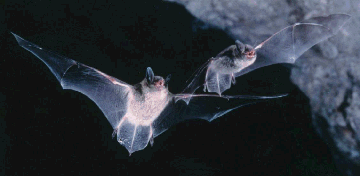 She brought in a very small suitcase about $30K dollars worth of high tech gadgets which are the tools of her trade. One piece was a small very high frequency omni-directional microphone, which could detect bat calls used for echolocation and navigation. Those sounds are “down-shifted” by a computer to a range where human hearing can detect them, and the signals are analysed and presented in a graphic fashion on a computer screen. Different species of bats can be distinguished by the wave forms they send, and the purpose of differing signals is being ferreted out: hunting, navigation and distress calls all showing differences.
She brought in a very small suitcase about $30K dollars worth of high tech gadgets which are the tools of her trade. One piece was a small very high frequency omni-directional microphone, which could detect bat calls used for echolocation and navigation. Those sounds are “down-shifted” by a computer to a range where human hearing can detect them, and the signals are analysed and presented in a graphic fashion on a computer screen. Different species of bats can be distinguished by the wave forms they send, and the purpose of differing signals is being ferreted out: hunting, navigation and distress calls all showing differences.
Some bat calls are audible in the human range, but they are “social” calls, used for signaling one another, sometimes to identify their group, and sometimes to signal territory boundaries. These calls are in the very lowest registers the bats can produce, and you might think of them as “grumbling” sounds in a human context.
She also demonstrated an infrared camera capable of seeing the dark brown bats as they streak across the night sky. They appear as “meteors”, or more properly as “ufos”, if they are changing direction in mid-flight.
A large part of Kelly’s research entails netting, identifying, assessing, banding and releasing bats. This is tricky work work, as the nets involved are exceedingly delicate, and can be quite large to set up. A large net can extend up to 60 feet (18m). The bats can often “see” and avoid them, so there’s some craft involved to effectively trap specimens.
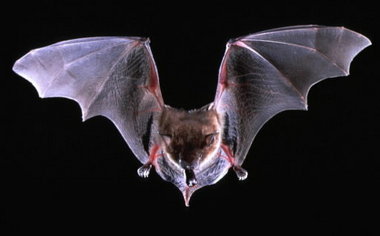 Another fun fact: some bat mothers carry their young with them in flight to protect and nurture them. Please remember, they are mammals. The research is interested in sexing the bats, so bat nipples are important to evaluate in the trapped animals.
Another fun fact: some bat mothers carry their young with them in flight to protect and nurture them. Please remember, they are mammals. The research is interested in sexing the bats, so bat nipples are important to evaluate in the trapped animals.
I wasn’t sure as I set out to this event if it would be worth the lost sleep, but was delighted with all I saw and learned. Bats are fascinating, and the store of knowledge about them has grown exponentially with the research and genetic tools now available to study them.
Living in a Small RV
Once Elliott got the mechanics of the RV figured out, it was time to discover how to live in it without stepping all over each other.
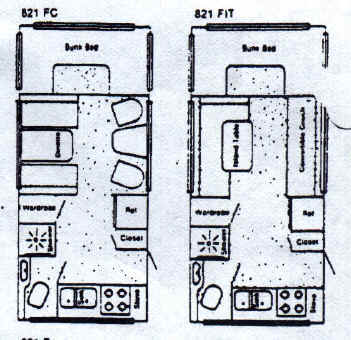 For example, the bed is up a short five-step ladder above the cab (see the bed above my head in yesterday’s post by Elliott). Whoever goes in first will have to climb over the other person if he or she needs to find the bathroom, 12 feet in the opposite direction–one reason to keep from drinking that third or fourth tea (or in my case, a second glass of wine…). We have to be fairly limber to just get INTO bed, much less crawl over someone on the way out in a space no larger than three or four stacked double mattresses, without heading head first down the ladder.
For example, the bed is up a short five-step ladder above the cab (see the bed above my head in yesterday’s post by Elliott). Whoever goes in first will have to climb over the other person if he or she needs to find the bathroom, 12 feet in the opposite direction–one reason to keep from drinking that third or fourth tea (or in my case, a second glass of wine…). We have to be fairly limber to just get INTO bed, much less crawl over someone on the way out in a space no larger than three or four stacked double mattresses, without heading head first down the ladder.
The refrigerator is slightly larger than a dorm fridge, and we discovered yesterday morning it has a tendency to freeze the fresh produce. Hopefully, the recent adjustment will take care of that without melting everything in the teensy freezer (current contents: two lbs. of coffee and a pint of ice cream). A small fridge is probably my biggest frustration so far, since we’ll be getting produce only about once a week at the farmers’ market–and I tend to go through a lot of produce in my cooking. So, for now, we’ll be having beans and rice, beans and pasta, beans and…more beans. I’m trying to think of it as practice for living on an imaginary sailboat for weeks on end! In the meantime, there’s more space for chilled beer–not a bad thing!
The shower is another place where space is constrained. Stand up and lift your elbows about three or four inches from your sides like a slightly demented robot. Now turn around. Yes, that’s how much space there is. That’s my foot in the shower, giving you a sense of relative size. 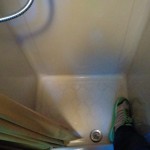 I’m exaggerating slightly, because the shower curtain gives you a little more flexibility, but a telephone booth (remember those?) would have given Superman a bit more to work with. It’s not like I didn’t expect it to be cramped, and it’s worlds better than the one in our LeSharo simply because you CAN stand up and take a shower, but it’s a reminder how luxurious a standard bath is.
I’m exaggerating slightly, because the shower curtain gives you a little more flexibility, but a telephone booth (remember those?) would have given Superman a bit more to work with. It’s not like I didn’t expect it to be cramped, and it’s worlds better than the one in our LeSharo simply because you CAN stand up and take a shower, but it’s a reminder how luxurious a standard bath is.
Cooking is…different. One large pot, one smaller pot, and a tiny fry pan mean a lot of one-pot meals are in our future. The large pot doubles as a salad bowl, and the colander doubles as a fruit basket to remind us to reach for fruit instead of chips and such. We also have a coffee maker (like I would live without one) and a small crock pot, and one of these cold evenings I’m going to set it up with oatmeal for in the morning. We turn on the hot water right before our shower or 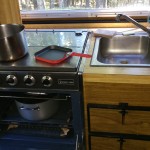 before we wash dishes, and then turn it off again when we’re done, and we turn on the propane stove as needed. By conserving gas, we hope to make it through the season without having to drive the ten very steep miles down to the propane supplier. Needless to say, it’s a one-cook kitchen.
before we wash dishes, and then turn it off again when we’re done, and we turn on the propane stove as needed. By conserving gas, we hope to make it through the season without having to drive the ten very steep miles down to the propane supplier. Needless to say, it’s a one-cook kitchen.
Overhead storage bins provide plenty of room for our clothes, and the pantry has plenty of space as long as you don’t mind hunting over and under other items for whatever it is you need. The big pot is stored in the oven. (Hey, I have an oven! Alas, no oven-proof dishes or pots.)
As a test experience, I gotta say that living in a small RV is working out just fine.
A & E on Orcas Isle: The American Clipper
There’s bound to be some interest from our readers about the “antique” motor home we’ve bought. It’s a 1976 American Clipper class C with a big block Dodge V-8. It showed up on a Craig’s List search for Bellingham, WA, which said it was located on Orcas Island, was in good running order, and was available for $4500 or best offer. A little further research revealed that it had been listed a few months earlier for $6500, so had been marked down, and sitting on the market for a while.
After a few minutes on the phone with Randy Davis, who was , I think, handling the sale for a third party, I began to think it might be just what we needed. Randy plainly stated that it was clean, and very well maintained, but had been sitting for quite a while. I asked him if it would safely make it to the top of Mount Constitution, a very challenging climb. He said he was pretty sure it would do that, but recommended that I have the brakes looked at. As it happens, Randy manages Gordy’s Garage at East Sound, Orcas Island, and would be glad to take care of that detail for us if we decided to buy.
I bit my lower lip, took a deep breath and offered him $4000, and asked if we could close the deal by mail. I also asked if he would he be able to keep the camper there for us until we got there in late July, and what would that cost? He said that price was fine, no problem, and no charge to store it. Deal done. Somewhere in there we also discussed that he couldn’t be certain that everything worked perfectly, but that at the price I was paying I was getting a very good machine, overall.
About doing business with Randy by phone, and with others on Orcas Island that I subsequently have called with questions, there’s this: The people on Orcas, so far, are VERY friendly, intelligent, thoughtful, humorous, helpful and honest.
So, meet “The Clipper”:
It is extremely clean inside and out, with light wear on the interior furnishings. While being almost 40 years old, it looks new-ish. It’s significantly bigger inside than our little LeSharo back home, and with a much more comfortable floor plan.
Initial issues included a minor plumbing glitch which fixed with a $1 fitting. Also, and more seriously, the old Dometic fridge was not, at first, getting cold. It didn’t have any ammonia smell (a sure sign of total failure), so I was hopeful. A bit of fiddling with the control contacts, a few jouncy miles of driving, and it suddenly sprang into life, so much so that we had frozen cantaloupe this morning for breakfast. Other items on the “to fix” list include a small fuel pump ($14) to make the 3 kW generator work again, and a new coach water pump ($60), to make the boon-docked water supply flow.
The engine was, at first, very temperamental. The gas was old, likely a crappy ethanol mix, and vehicles hate to sit too long unused. Fifteen gallons of hi-test, and about 5 miles of driving, and it smoothed out just fine. I’ve learned that it’s important to warm it up. It stoutly climbed all the way to our home atop Mount Constitution without a stutter or a cough.
The Clipper is proving to have been a really great plan; both comfortable and satisfying. I’m very grateful to Randy Davis for helping us obtain and get settled in it. If you’re ever in East Sound and need something done to your vehicle, look him up at Gordy’s Garage, and tell him I sent ya.
Here’s a gallery of The Clipper:
Getting to Orcas
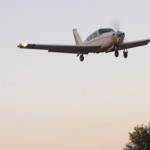
We said goodbye to Seattle about 10:00 a.m. on Saturday, I think. (Already I’m losing track of the days.) About 30 minutes north, we stopped at a Fred Meyer store in Everett to make last-minute supplies and grocery purchases. (For all you East Coasters, Fred Meyer stores are a lot like mini-WalMarts–pretty much all of the same supplies, but with fewer options of each.) Traveling as far west as Albuquerque in a small plane meant that we had limited weight and space restrictions, so “essentials” like folding chairs, dishware, and even bulky pillows were not included in our take-off plans. We had restricted ourselves to 50 lbs. each for clothes and personal items (including laptops and electronics), and then 50 lbs. for “community” items such as tools for any eventuality, blankets, pots and pans, and so forth. We managed to come in at about 40 lbs. each and an additional 40 lbs. for the rest, for a total of 120 lbs., well under the weight of an assumed 150-lb. back-seat passenger. Because weight and density altitude make it difficult to land in emergency situations, we wanted to be sure we could take off on shorter runways; though we never needed a longer runway, it gave us some measure of reassurance to know we were prepared.
Fred Meyer turned out to have pretty much everything we anticipated needing–but since our camper was as yet sight unseen and not tested, we held off on anything that might need refrigeration. (Isn’t it handy that red wine doesn’t need refrigeration? I think so.) This was our last chance to make purchases on the mainland–after this, we were going to be paying island prices. We ended up getting more cans of beans than Elliott imagined, and a lot of rice and pasta to tide us over. (I am eagerly awaiting the farmers’ market in Eastsound on Saturday.)
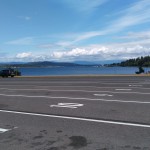 We made it to the ferry with almost two hours to spare and indulged in reading our books and people watching as we waited to drive onto the ship. The ferry was amazingly clean and calm, though we had a few moments of consternation when the loudspeaker announced, “Would the owners of the black Audi A6 with New Mexico plates please disable your car alarm.” Car alarm? We have a car alarm? By the time we got there with the key, the alarm had stopped, but we stayed with the car the rest of the journey to shore.
We made it to the ferry with almost two hours to spare and indulged in reading our books and people watching as we waited to drive onto the ship. The ferry was amazingly clean and calm, though we had a few moments of consternation when the loudspeaker announced, “Would the owners of the black Audi A6 with New Mexico plates please disable your car alarm.” Car alarm? We have a car alarm? By the time we got there with the key, the alarm had stopped, but we stayed with the car the rest of the journey to shore.
We landed on Orcas Island without further incident, and drove the few miles to Gordy’s Garage, where Randy Davis met us with the keys to our “new” 1976 American Clipper RV.
A & E, Great Escape: Seattle: friends, furnishings and frogs…
Leaving Ontario, the chief delight for scenery on the road was the windmill farms. They stood on the ridges, sometimes in sentinel solitude, sometimes in rows, sometimes in various sizes, tall medium and small, like those sticker families you see pasted on the rear windows of minivans, depicting the families inside. Wind power is the most pragmatically practical you could ask for; the winged machines that gather it are elegantly beautiful, and yet it amazes me that many people protest that wind farms are a blight on the land and sea-scape. People ought to realize how many smokestacks and gutted coal mountains those whirly-gigs replace.
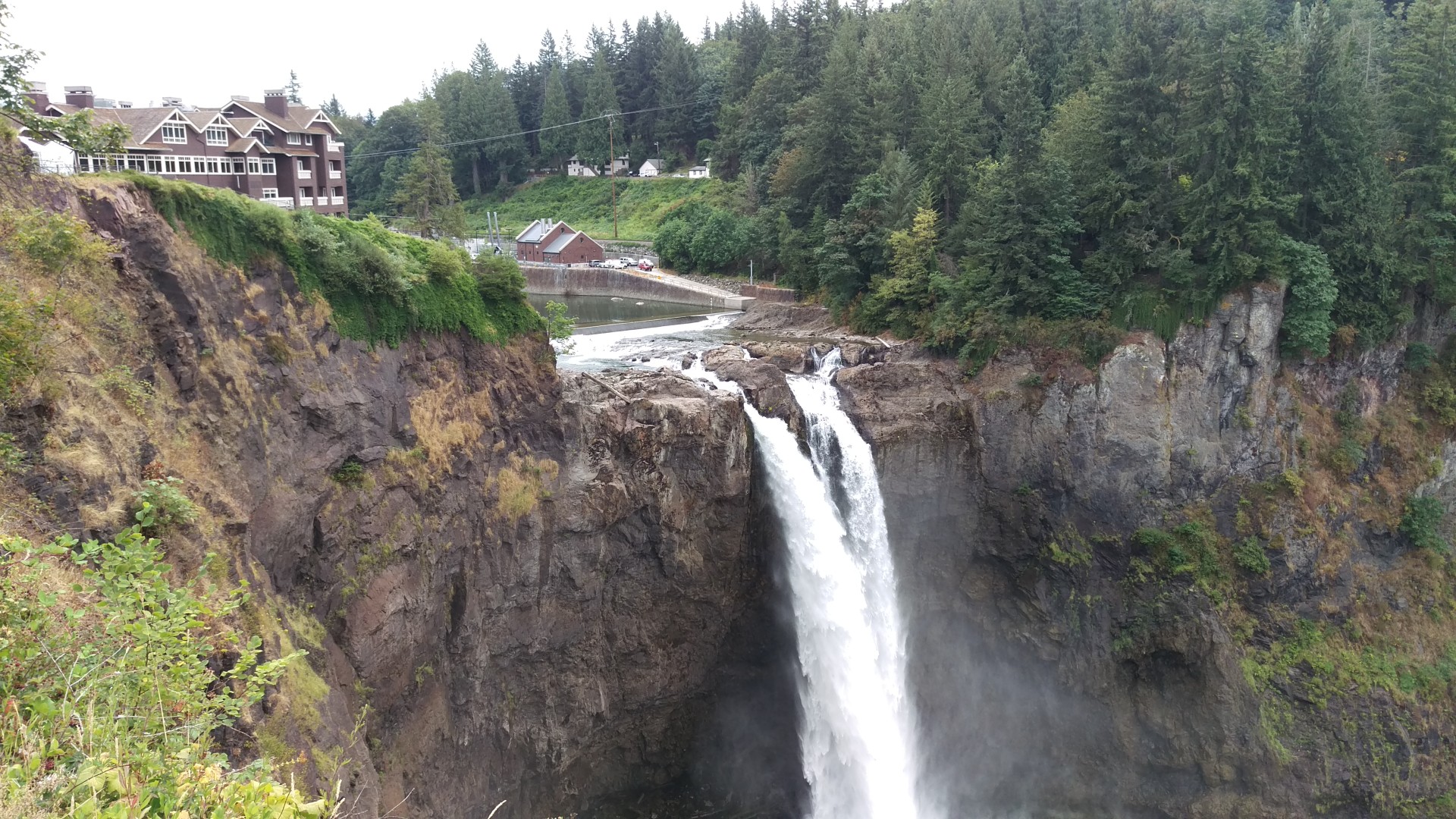 We did take a sidetrip to North Bend to see the falls, and take snapshots of ourselves outside the “Twin Peaks” diner. Alas, the place was mobbed, and seemed to be functioning with a single waitress and no busboys. It seemed unfair to burden the poor woman with yet two more plates of cherry pie to fetch, so we skipped the pie, and drove on.
We did take a sidetrip to North Bend to see the falls, and take snapshots of ourselves outside the “Twin Peaks” diner. Alas, the place was mobbed, and seemed to be functioning with a single waitress and no busboys. It seemed unfair to burden the poor woman with yet two more plates of cherry pie to fetch, so we skipped the pie, and drove on.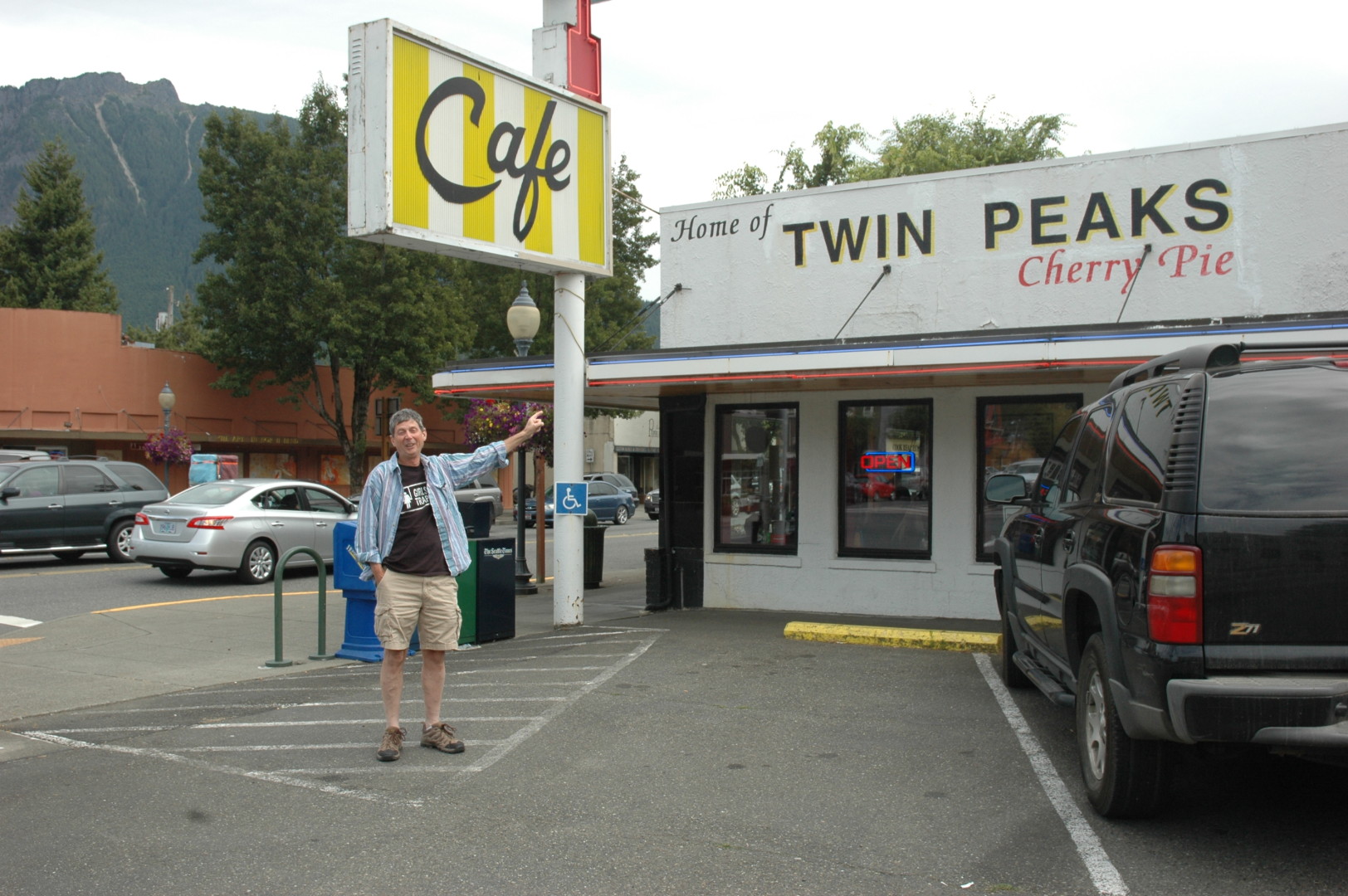
Seattle’s traffic rivals D.C. Now, about Kendra:
Kendra is our friend in Seattle. She’s been a teacher and a librarian all her life, until retiring just this past summer. She was the first friend I made in Houston, Texas, when I arrived there fresh from my air force stint. She was an important part of the story of Ann and I becoming Us. And we hadn’t seen her for something like twenty years. Long story short, friendships like that rekindle instantly. Your kindred spirits will fall in with you, “get you” and “be gotten by you” in the blink of an eye, even after all those years. It was wonderful seeing her.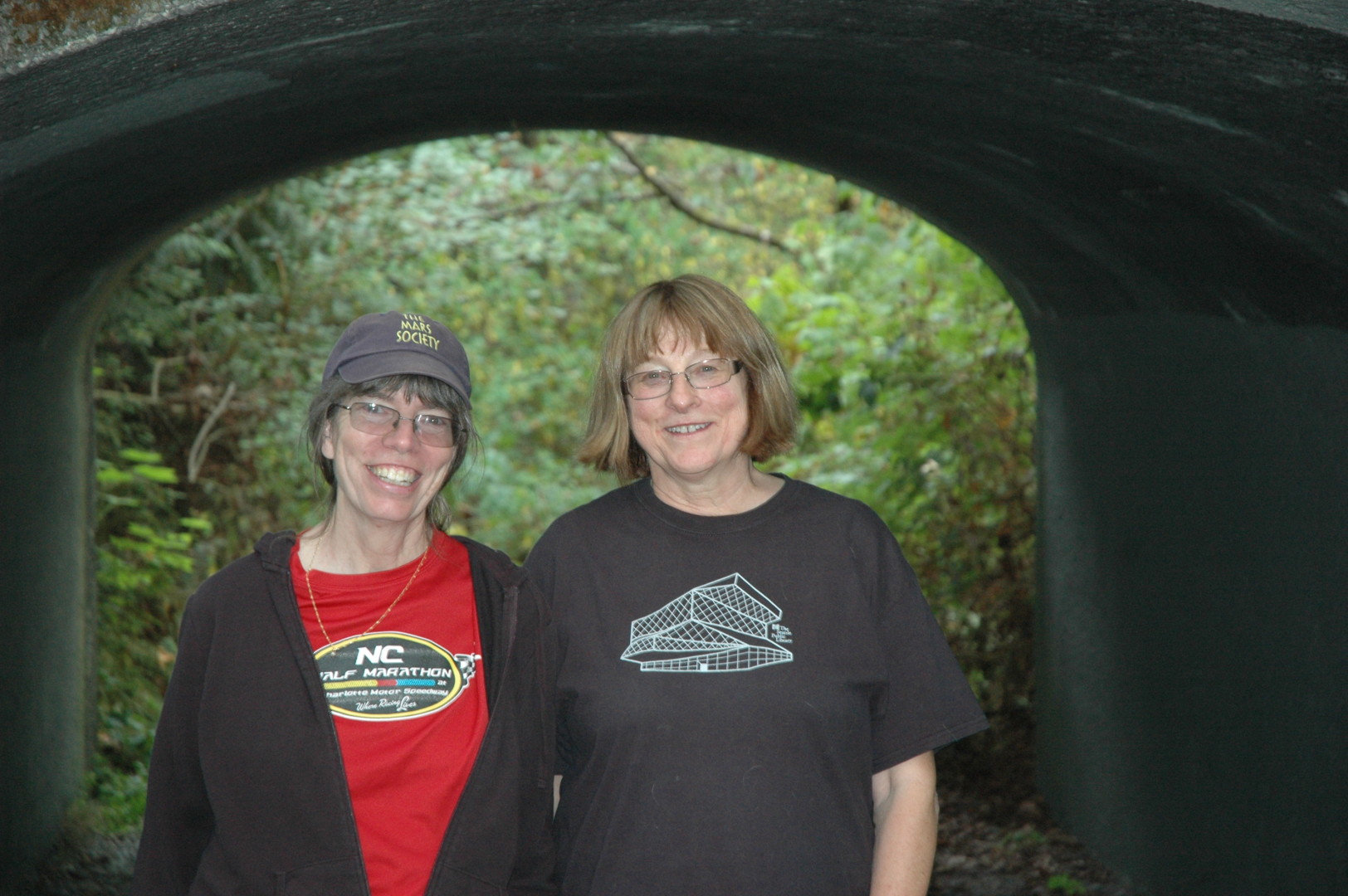
She has a friend, Dale, who was cleaning up after a yard sale that day, and invited us to pick anything that was left over to furnish our camper. We found towels, sheets, a pillow case and pillows, and even a spare blanket to feather our yet “unseen” nest for the Orcas stay. Dale was moving away from a home she’d lived in for more than twenty years, and clearly loved. She gave us a tour, talking about the place; the fireplace insert, and garden plants. She had herself dug out a huge pond, almost four feet deep, lined it and fashioned a water course with a circulating pump to aerate the water, and all for the purpose of helping to reestablish frog populations.She had grown up in the same neighborhood, and noted how the frogs she’d remembered were vanishing. The frogs had been dying off from pesticide use and other pollutants. They are an indicator species, canaries in the coal mine of our environment, which provide an early warning when the toxicity is rising. With its lily pads, ferns, flowering water plants, and wriggling tadpoles, it was the most beautiful pond you could ask for.
Dale is hoping the new owners will take care of her pond. Me, too…
Ann’s Ruminations
Elliott has always loved hiking in the desert, so I was looking forward to seeing its appeal through his eyes when we finally got to the West Texas/New Mexico area. Mother Nature, however, had other ideas. Still, the green desert–unusually verdant for the season–had a stark beauty to it that made me think, “I could live here.” I loved the traditional architecture and the way New Mexico has adapted Mexican and Indian heritages, especially with regard to food (always a happy trigger for me). I could definitely see the attraction.
Then we found our way to a small community just west of 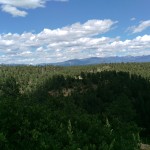 Pagosa Springs, Colorado, overlooking the Rocky Mountains. Deer bedded down a few hundred feet away, horses and wild turkeys roamed the area, and I once again thought, “Maybe I could live here.” (Note: I have no intention of moving, but this is a game I play with myself wherever I go. I have no idea why. The grass is always greener syndrome, maybe.) The peace and quiet was soothing after four days on the move. It had a different beauty from the desert, more in keeping with my Midwest and East Coast sense of wilderness. I kept my eyes open for elk, but apparently they’ve moved further upland during the summer.
Pagosa Springs, Colorado, overlooking the Rocky Mountains. Deer bedded down a few hundred feet away, horses and wild turkeys roamed the area, and I once again thought, “Maybe I could live here.” (Note: I have no intention of moving, but this is a game I play with myself wherever I go. I have no idea why. The grass is always greener syndrome, maybe.) The peace and quiet was soothing after four days on the move. It had a different beauty from the desert, more in keeping with my Midwest and East Coast sense of wilderness. I kept my eyes open for elk, but apparently they’ve moved further upland during the summer.
Driving through the canyon country (which I hadn’t seen since I was maybe twelve years old, competing four? five? probably not six? younger siblings for a view), with nary a homesite in view, I could imagine how the pioneers felt as they crossed the country. I wondered what it would be like to live that far from civilization. I could do it, I figured, though it might be difficult living that far from neighbors, so I added “for a while,” and then, “but maybe not in winter.” Windmill farms occasionally dotted the landscape, and I found myself mesmerized by their gracefulness and purpose. There should be more windmills in the world. “Blowin’ in the Wind” kept tumb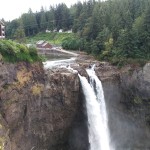 ling through my brain. We made a brief stop at the waterfalls in North Bend, then headed into the city.
ling through my brain. We made a brief stop at the waterfalls in North Bend, then headed into the city.
Seattle was amazing, even though we were there for less than a day. Definitely on my come-back-to list. The overpass parks were such a good use of space, I wish we’d had more time to explore them. More greenspace, fewer cars–thought admittedly it’s ironic that such a thought occurred to me from a car, traversing 3000 miles to volunteer for two months in a different greenspace. Seattle gets far less snow than I had thought, but the traffic jams? I could live without them. Still, I could–yes–live there. I find myself torn between the energy and life of a city, and the relaxing pace and peace of the country. After a hike around the city down to Lake Washington, Kendra and Rod took us to an old Hudson factory for dinner. We hadn’t seen Kendra for about 20 years, but felt like it hadn’t been nearly that long (and of course we hadn’t aged a bit!) and catching up was fun. I held my tongue and never mentioned leather coats and flashing (Ooops!).*
We took the ferry from Anacortes, Washington, to Orcas Island, after a stop at a Fred Meyer store north of Seattle to stock up on unperishables and supplies. We weren’t sure if the refrigerator wou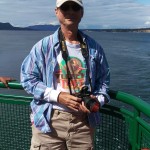 ld work (and it doesn’t appear to–a problem to solve another day), so we held off on fresh vegetables and anything that required refrigeration.
ld work (and it doesn’t appear to–a problem to solve another day), so we held off on fresh vegetables and anything that required refrigeration.
Orcas Island is full of tiny touristy villages surrounded by state parks, and we’ll probably head to a staging campground in the park tonight. We hadn’t been here more than a couple hours before Michel, one of our park coordinators, came over to greet us and make sure we had everything we needed. Julia, our other coordinator, called this morning to verify we had everything too–we feel very welcomed, indeed.
We’re off in a bit to find a part for the water system so that we can have actual connected water (it will make life much easier) as opposed to hose water, and get that system working before rainfall.
We’re settling into the RV–right off the departure end of the local airport–and I can easily see us here for the next couple of months. I could live here, yes indeedy.
*A story for another time…
A&E’s Great Escape: Moab, Utah to Ontario, Oregon
After the Mesa Verde hike, and the sumptuous drive north into Utah, we arrived on the evening of Ann’s birthday in Moab, almost too tired to move, or even feel hungry. The innkeeper at the Apache Motel, a lovely Mormon mom, was summoned to assist me by one of her three cherubic daughters. She arrived with an infant son in one arm. She checked us in, and suggested a vegetarian resturant a few blocks away, called The Peace Tree. Downtown Moab is quite a scene, with bikers, hikers, and other sundry transients, so we felt at home as passers-by among them. The Peace Tree proved excellent for the Walnut Apple and Quinoa salads, respectively.
We returned to the motel, donned earplugs against the noisy window air conditioner, and slept well enough.
Mindful that we were on a schedule to reach Orcas Isle, the following morning was a push-hard driving day. We arose at 6:30, partook of the motel coffee and buns, and set off. I regretted not having the time to linger at Arches National Park, but promised myself to return some day. We sped north and west, and blew past Boise, Idaho, to arrive in Ontario, Oregon at 6:30pm. A Chinese resturant earned our custom for dinner.
We’ve found on this trip that small town Chinese buffets have been a good choice for evening meals; certainly better than fast food drive thru meals, which neither of us care for. If you take small servings and aim for veggies, they are satisfying and reasonably healthy overall, with a few bites of guilty-pleasure foods mixed in, too. We dined at such a buffet back in Plainview, Texas.
Leaving Ontario, our next stop was to be Seattle, and our final preparations for Orcas Island and Mount Constitution…
Stray road thoughts…
When this project got started, this uprooting ourselves from the daily routine of our jobs and careers to volunteer at Moran State Park, my first notion was that we should fly all the way there in our single engine airplane. Although I’ve been a pilot since the 70s, and logged almost 2000 hours of private flight, this journey would have been the longest trip I’d ever have made on my own wings. I was also thinking it would be handy to have the use of the plane to explore the region during the weeks we were there.
So when it happened that the plan shifted to “fly-and-drive”, I was wondering how I would feel about it. The reasons were practical: our housing at Moran will be an antique Class C motor home we found through Craig’s List on Orcas Island. It’s waiting there for us now, but it wasn’t going to serve as a “get-around” vehicle. The park is on top of Mount Constitution, with a narrow track of switch-backs and some 2200 feet to climb up or down. My friend, Bill Hawk suggested we borrow his older Audi station wagon, and use it for the time up there. Wheels, and damn nice ones, too! Thanks, Bill!!!
And here I am, blogging my way across Oregon and Washington this morning, as Ann manages the tiller. So, how do I feel about it? Pretty wonderful, actually. The road has been beautiful, stimulating and thought-provoking in ways flying cannot be for me. It’s restful compared to flying, which is intense and demanding of attention, even in preparation for departure, and after landing too, when getting the plane properly settled and attended to kicks in.
Driving, we’ve been able to savor our passage across this beautiful countryside. I do look forward to getting back to our bird next October, but I’m not disappointed at all with the journey as it’s shaped up. Today we will take the advice of our friend, John Strickler, and try the coffee at Twede’s Cafe, North Bend, Oregon, where David Lynch filmed Kyle MacLachlan waxing lyrical over the cherry pie in the tv series, ‘Twin Peaks’.
“Damn, good food, Diane. That cherry pie is worth a stop.” – Special Agent Dale Cooper, ‘Twin Peaks’
